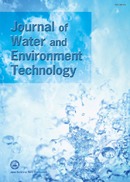All issues

Volume 12, Issue 5
Displaying 1-3 of 3 articles from this issue
- |<
- <
- 1
- >
- >|
Original Papers
-
Namita MAHARJAN, Kazuya DEHAMA, Kota OHTSUKI, Yayoi SAITO, Yuma MIYAOK ...Article type: Original Paper
2014 Volume 12 Issue 5 Pages 421-429
Published: 2014
Released on J-STAGE: October 10, 2014
JOURNAL FREE ACCESSIn order to fulfill the imperative need of proper organic matter and nutrient removal technology, an integrated system of up-flow anaerobic sludge blanket (UASB), down-flow hanging sponge (DHS) and anaerobic/anoxic sequencing batch reactor (A2SBR) is developed in this study. An aerobic reactor called DHS has porous sponge material for oxygen supply and microbes retention. Likewise, A2SBR is reported to remove nutrients, like phosphorus and nitrogen, effectively using denitrifying phosphorus accumulating organisms (DNPAOs) with less sludge production. The findings of this study demonstrated that the average SS, COD and BOD removal efficiencies by UASB-DHS were 86%, 87% and 97%, respectively, in summer and were 69%, 78% and 88%, respectively, in winter. Moreover, upon adjusting the pH to 7.4 ± 0.2 and with COD/P of 20, phosphate removals as low as 1 mg-P/L and nitrate concentration as low as 5 mg-N/L were achieved. Therefore, this proposed system could be an innovative solution for the present prevalent municipal wastewater treatment problems due to its effective organic and nutrient removal capabilities.View full abstractDownload PDF (976K) -
Shigeo HOSONO, Nobutoshi OHTSUKA, Kotaro MINOMO, Mitsuo SUGISAKI, Kuni ...Article type: Original Paper
2014 Volume 12 Issue 5 Pages 431-445
Published: 2014
Released on J-STAGE: October 10, 2014
JOURNAL FREE ACCESSA specific dioxin composition was detected in some sediment samples collected from the highly polluted Furuayase River, Japan. The dominant tetrachlorodibenzofuran (TeCDF) congeners in the samples were 1,3,7,8- and 1,3,7,9-tetrachlorodibenzofuran (1,3,7,8-/1,3,7,9-TeCDF). To identify the sources of the pollution with the specific dioxin composition, the dioxin compositions were studied in samples of drainage discharge water, sewage discharge water, and sludge in the sewage works from four chemical factories located in Furuayase River drainage basin. The specific composition was detected in the sewage discharge water and the sludge in the sewage works of one factory. This factory had previously produced 2,4,6-trichlorophenylhydrazine (TCPH) as an intermediate in the synthesis of a photographic medicine. It was investigated whether dioxin impurities were present in commercial TCPH reagents and whether 1,3,7,8-/1,3,7,9-TeCDF by-products might be formed during manufacture of TCPH. The dioxin homologue and congener profiles from one commercial reagent were similar to those of the sewage discharge water and sludge in the sewage works from the aforementioned factory. Our results indicated a possible pathway for the generation of 1,3,7,9-TeCDF during manufacture of TCPH.View full abstractDownload PDF (1498K) -
Fumihiko OGATA, Ayaka UEDA, Naohito KAWASAKIArticle type: Original Paper
2014 Volume 12 Issue 5 Pages 447-458
Published: 2014
Released on J-STAGE: October 10, 2014
JOURNAL FREE ACCESSPoly-γ-glutamic acid and flocculants (PGAF) were prepared for the removal of phosphate ions from aqueous solution. Scanning electron microscopy images of PGAF were obtained, and the amounts of calcium and oxygen on the PGAF surface were confirmed by electron probe microanalysis. The removal percentage of phosphate ions by PGAF was 98.2% within 10 min. Hydroxyapatite (Ca10(PO4)6(OH)2) and calcite (calcium carbonate) were produced by adding PGAF to a phosphate ion solution. These products were collected using poly-γ-glutamic acid and precipitated in aqueous solution. The results suggest that the removal rate of phosphate ions is very fast, and solid/liquid separation is achieved very easily using PGAF. Moreover, the removal of phosphate ions by PGAF increased as the amount of adsorbent was increased. The optimal agitation speed for the removal of phosphate ions was 60 - 120 rpm, whereas the temperature and solution pH did not affect the removal of phosphate ions. Therefore, PGAF may be useful for the removal of phosphate ions from aqueous solution.View full abstractDownload PDF (2302K)
- |<
- <
- 1
- >
- >|